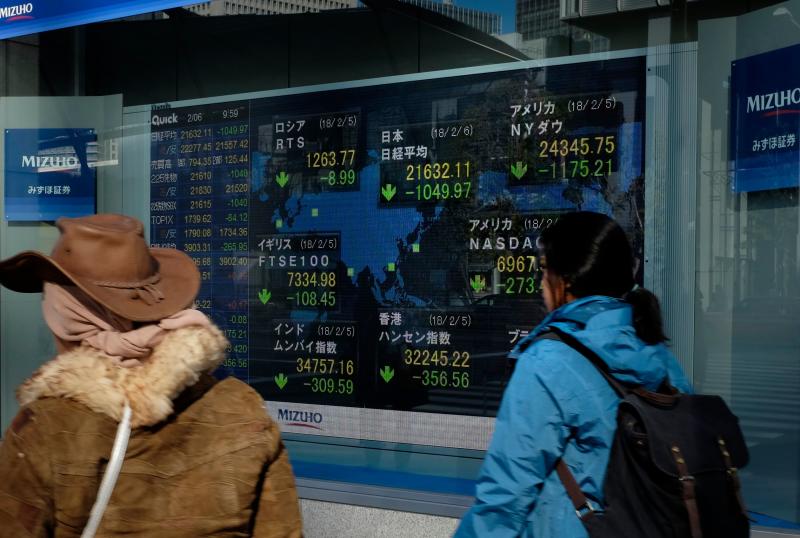Asia, Europe stocks tumble as global sell-off deepens; STI closes down 2.2%
Sign up now: Get ST's newsletters delivered to your inbox

The electronics stock indicator showing the numbers on the Tokyo Stock Exchange on Feb 6, 2018.
PHOTO: AFP
Follow topic:
LONDON (REUTERS, BLOOMBERG) - The global equity rout extended on Tuesday (Feb 6) as first Asian and then European markets tumbled, sending a gauge of world stocks toward the biggest three-day slide since 2015.
"Let's be clear: in the long span of financial history, this is not news," said James Bateman, CIO of multi asset at Fidelity International. "In a world where the concept of a 'correction' almost feels alien and where equities felt like an unstoppable one-way bet for a while, the normality of a setback can feel more painful."
What began with rising bond yields has become a selloff across global equity markets, as investors fret the return of inflation and higher rates that could erode profitability for companies already trading at elevated prices. Traders will be watching how the moves unfold from here - a sustained stock slump has the potential to undermine sentiment, crimp borrowing and so start to curtail global growth.
The four-day rout has seen US$4 trillion wiped off from what just eight days ago had been record high values.
Europe's main bourses started down as much as 3 per cent, leaving investors with little option but to seek the traditional refuges of gold, the Japanese yen and one of the initial triggers for the selloff - benchmark government bonds.
Wall Street futures offer a chink of light as they turned higher but commodities suffered too, with oil and metals all tumbling backwards as what had been one of their best starts to a year also soured rapidly.
The stock selloff had been viewed by some as a healthy correction following their rapid rise over the last year but, as it snowballed through Asia and then Europe, nerves were starting to fray.
Wall Street's Dow Jones and S&P 500 benchmarks had slumped 4.6 per cent and 4.1 per cent on Monday, their biggest drops since August 2011. It was also the Dow's biggest fall on a pure points basis of all-time.
Europe's early drop sent the region's STOXX 600 to its lowest level in six months. There was intense trading activity, with more than 40 per cent of the average daily volume traded on Germany's DAX and Europe's STOXX 50 by 0845 GMT.
"Since last autumn, investors had been betting on the 'Goldilocks' economy - solid economic expansion, improving corporate earnings and stable inflation. But the tide seems to have changed," said Norihiro Fujito, senior investment strategist at Mitsubishi UFJ Morgan Stanley Securities.
In Asia, MSCI's broadest index of Asia-Pacific shares outside Japan slid 3.4 per cent. Taiwan's main index lost 5.0 per cent, its biggest since in 2011 and Hong Kong's Hang Seng Index dropped 4.2 per cent.
Japan's Nikkei dived 4.7 per cent, its worst fall since November 2016, to four-month lows.
Singapore's Straits Times Index closed 76.55 points or 2.2 per cent lower, paring an earlier 3.5 per cent drop.
The original trigger for the global sell-off was a sharp rise in US bond yields late last week after data showed US wages increasing at the fastest pace since 2009. That raised the alarm about higher inflation and, with it, potentially higher interest rates.
That could be painful for markets that have been propped up by central banks' stimulus for many years.
The 10-year US Treasuries yield rose to as high as 2.885 per cent on Monday, its highest in four years and up 47 basis points since the end of 2017.
But a massive fall in share prices prompted an about-turn, and on Tuesday, it fell back to as low as 2.662 per cent. German Bunds, Europe's equivalent benchmark then fell 5 basis points in early trading, their biggest drop in over two months.
US interest rate markets are now pricing in only two Federal Reserve rate hikes this year, a big shift from only a few days ago when they were pointing to three or even four hikes.
The CBOE Volatility index, the closely followed "fear-index" measure of expected near-term stock market volatility, jumped 20 points to 37 its highest level since August 2015.
That left some popular exchange-traded products that investors use to benefit from calm market conditions facing potential liquidation.
Keen to avoid further risk, investors are closing their positions in other assets, including the currency market, where a popular strategy has been to sell the dollar against the euro and other currencies seen as benefiting from higher interest rates in the future.
The euro was sold off on Monday but popped back up to US$1.2435 on Tuesday. It took it away from last week's low of US$1.2335. That could usher in a further correction after its rally to a 3-year high of US$1.2538 late last month.
Against the yen, which is often used as a safe-haven currency because of Japan's solid current account surplus, the dollar slipped as much 0.2 per cent to 108.86 yen before clawing back to 109.3.
Oil prices also dropped, with international benchmark Brent futures hitting a one-month low before recovering to stand at US$67.28 per barrel, down 0.5 per cent on the day.
US crude futures traded at US$63.87 per barrel, down 0.6 per cent, while safe-haven gold was up for a fourth day in the last five, at US$1,340 per ounce.

